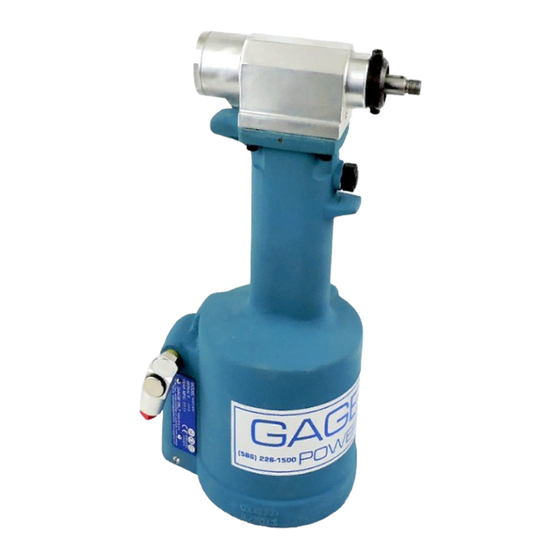Gage Bilt GB740 설치 매뉴얼 - 페이지 7
{카테고리_이름} Gage Bilt GB740에 대한 설치 매뉴얼을 온라인으로 검색하거나 PDF를 다운로드하세요. Gage Bilt GB740 12 페이지.
Gage Bilt GB740에 대해서도 마찬가지입니다: 원본 사용 설명서 (20 페이지)

FILLING AND BLEEDING TOOL
WARNING
DO NOT CYCLE TOOL WITHOUT AIR BLEEDER, OR THE SCREW AND STAT-O-SEAL, INSTALLED IN TOOL HEAD. SEVERE
PERSONAL INJURY MAY RESULT.
CAUTION
BEFORE FILLING HANDLE, AIR PISTON SHOULD BE ALL THE WAY DOWN.
To replace a small amount of oil in the tool, attach the air bleeder and connect tool to air line. Cycle a number of times. Disconnect
air, remove the air bleeder, and reinstall the cap screw. This will ensure the removal of any air from the hydraulic system and its
replacement with fluid.
* FILLING & BLEEDING VIDEO AVAILABLE AT: www.gagebilt.com/bleeding.htm
Should it become necessary to completely refill the tool (such as would be required after tool has been dismantled and reassembled),
take the following steps after depressing trigger
1. Remove head assembly from handle assembly. Slowly push piston completely forward.
2. Fill handle reservoir and the oil passage on top of handle with automatic transmission fluid, Dexron III or equivalent. When
looking at the top of the handle, the oil passage is the hole that is counterbored for o'ring (S832).
3. Replace head assembly with care, ensuring gasket (704129) and o'ring (S832) are properly installed. Tighten cap screws (402479)
uniformly to prevent leakage around gasket.
4. Remove screw (402482) and stat-o-seal (S572) install bleeder bottle (704153) and connect tool to air line, cycle ten to twenty
times to fully circulate fluid through hydraulic system.
5.
DISCONNECT AIR FROM
cycle tool 10 more times. Check tool stroke, if stroke doesn't check 1.330" (33.78mm) min. (See figures below) repeat steps
4 & 5.
.830 (21.08mm)
TROUBLESHOOTING
Providing all maintenance conditions have been met, follow this systematic approach to diagnosis.
1. MORE THAN ONE PULL IS REQUIRED TO BREAK RIVET.
a)
Tool needs to be bled. (See filling and bleeding instructions.)
b)
Spring has fatigued, replace.
c)
Jaws are stripped or packed with chips. Clean or replace.
d)
Incorrect nose tip.
2. SLOW OR PARTIAL OPERATION WHEN THE TRIGGER IS DEPRESSED
a)
Head Piston Rings (A-294) and (S108) could be worn or damaged. Replace.
b)
Piston Rod Rings (A-201) and (S908) could be worn or damaged. Replace.
c)
Muffler (704146) or filter inside spool (703142) may be plugged. Clean thoroughly and back-blow with compressed air.
d)
Hole in metering screw in valve spool (703142) may be blocked or damaged. Hole diameter should be .028". Clear and size
or replace.
3. NO OPERATION WHEN TRIGGER IS DEPRESSED
a)
Tool seized due to mechanical failure or damaged parts.
4. OIL LEAKAGE
a)
DO NOT
OPERATE WITH OIL LEAKING FROM TOOL. HIGH PRESSURE OIL MAY CAUSE SEVERE PERSONAL INJURY.
b) Any oil leaking externally should be traced to its source. An o'ring or seal that leaks should be replaced.
5. AIR BYPASS FROM VALVE HOUSING
a)
If the spring (704141) breaks or dislodges, air will flow freely through the muffler (704146). Replace or reset. Valve spring
installation tool (704162) is recommended.
b)
Check o'rings on valve sleeve (703139), valve spool (703142), and valve plug (704145). If worn or damaged, replace. Valve
sleeve removal tool (704163) is recommended.
6. FASTENER STEM JAMMED IN NOSE ASSEMBLY
a)
Nose assembly components require service.
disassemble. Replace worn or broken parts. Clean the surface the jaws ride on.
b)
Stems lodged side by side in the follower. Disassemble, remove stems, and reassemble.
AND DISCONNECTING THE AIR SUPPLY:
TOOL. Remove bleeder bottle (704153) install screw (402482) and stat-o-seal (S572). Reconnect air and
"A"
DISCONNECT AIR FROM
TOOL, remove the nose from the tool and
7
"B"
.500 (12.70mm)
Rev. 3/13
